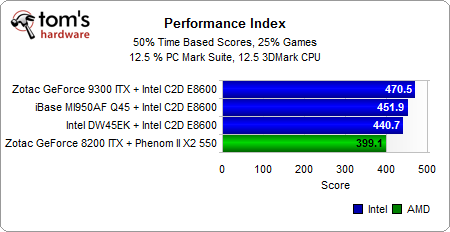Mini-ITX: Two Cases And Four Motherboards Compared
Conclusion
We've looked at a number of mini-ITX products to get a feeling for what customers can expect if they decide to miniaturize their machines. Two cases by Antec and SilverStone, as well as four motherboards by iBase, Intel, and Zotac, made it into our lab. The enclosures differ in size and power supply, but we found more significant differences between the motherboards. None is suitable for serious overclocking and most aren’t particularly efficient on power.
Cases
The two cases by Antec and SilverStone are completely different. Antec goes for minimum dimensions and a relatively weak external power supply, which means that it will be perfect for living room PCs or other places where small size matters. But this also means that you can’t use any fast processors. The Antec ISK 300-65 is probably best suited for Atom (cringe) or entry-level Core 2 solutions. SilverStone’s SG05 is a fully-featured PC case able to host a 3.5” hard drive and up to two full-height expansion cards, such as graphics accelerators.
Platforms
On the platform side, the two Intel chipset-based solutions (iBase's MI950AF and Intel’s DQ45EK) are suitable for small form factor desktop replacement PCs. Both feature eSATA, two display outputs, and sufficient connectivity. But they lack support for faster processors and their upgrade path is limited to 32-bit PCI (iBase) and single-lane PCIe (Intel). Performance differences between the Intel solutions are small and only noticeable if you compare Intel with Nvidia graphics.
Zotac provided two platforms for review, one for AMD’s Socket AM2+ processors with a GeForce 8200 chipset and the other for LGA 775-based Core 2 CPUs through Nvidia’s GeForce 9300 graphics chipset. The AMD platform has a general disadvantage when compared to the Intel solution because of the Phenom II X2 processor we used. Despite being AMDs top dual-core model, it provided less performance at higher power consumption than the Core 2 Duo test systems. Therefore the GeForce 8200 ITX WiFi is only a good choice if you want or need an AMD platform.
And the Winner is…
Get Tom's Hardware's best news and in-depth reviews, straight to your inbox.
The GeForce 9300 ITX WiFi offers comparably fast 3D performance and a feature set that is far superior to the other solutions. Not only does it feature 802.11 b/g wireless (the AMD counterpart does, as well) but it also comes with HDMI, DVI, and VGA display outputs, eSATA, a reasonable 4-phase processor voltage circuit, and a full x16 PCI Express interface. Since this is the only mini-ITX platform that is truly a desktop replacement, it is the only really flexible product and receives our Recommended Buy Award.
Current page: Conclusion
Prev Page Benchmark Results: Power Consumption And Efficiency
